By James C. Fulmer | Past President, NMLRA
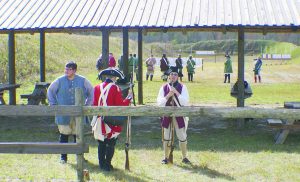
One of the many ranges at the “Alafia” River Rendezvous.
“Retirement is never having to ask for time off from work from your employer again.” Yes, I am retired now and these words best describe retirement, except I am learning there are only 52 weekends in a year and the only thing I gained is the travel and getting prepared between the muzzleloading events I do around the country. There is no need to rush back Monday for work or cancel plans because of having to work a weekend. It is great. I retired Dec. 1, 2017, and am already starting to do the bucket list of rendezvous and historical sites I want to see with this new-found time.
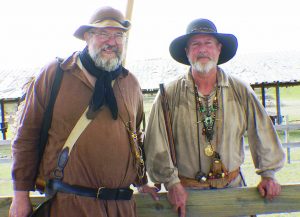
Author (left) with Alafia’s Chief Range Officer Mark Landon.
I retired in December with plans of making sure I made it to the Alafia River Rendezvous this year, which would take place Jan. 17-19 in Homeland, FL. I had plans of packing up the flintlock rifle and wedge tent and flying. I was just going to visit for several days and shoot some. Then I got a call from my brother. I have three brothers all older and all have been waiting for my retirement. Elmer the oldest lives in Dallas, TX; Richard lives in Gillett, PA, and the third one, Allen, lives in Elmira, NY. Richard already was going to Gulf Shores, AL, to golf and so Elmer and I planned to meet him there for a week, but in doing that I would just catch visitor’s days at the Alafia on Jan. 26 and 27. So off to Gulf Shores I went.
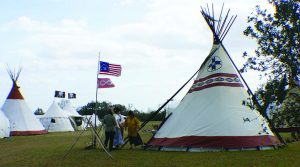
Most tipis the author has seen in the Eastern US in years.
There is history at every turn at Gulf Shores. Fort Morgan is just a short distance from Gulf Shores so I went to visit the site and found a lot of interesting history. I didn’t know about the forts that guarded Mobile Bay. Ft. Morgan guards the entrance to the bay along with Ft. Gaines, which is to the west on Dauphin Island. This area of Alabama had many flags flown over it. Spanish explorers visited Mobile Bay, but never settled the area. The French would settle the area and their first capitol of the area was Twenty-Seven Mile Bluff, but would move first to Mobile and then finally to New Orleans. After the French & Indian War, Spain would acquire Louisiana including New Orleans. The British acquired southern Mississippi, lower Alabama, and Florida. Mobile Bay would become part of West Florida and Pensacola would be the capitol. From the end of the French & Indian War until the American Revolution, the British controlled this area. But, in 1779, the Kings of France and Spain (who were cousins) signed an alliance against England. The Spanish governor of Louisiana would lead Spanish and French forces against the British and by 1781 the British presence in the Gulf of Mexico had ended.
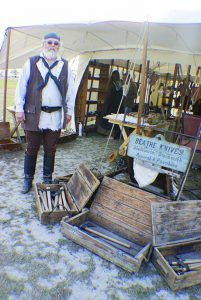
Mike Beathe was one of the many vendors at the Alafia Rendezvous.
But the United States and Great Britain began fighting over trading rights and maritime issues and would go to war again. The War of 1812 would begin and the British forces where able to land and raid all up and down the east coast, even managing to burn Washington, DC. It was the defense of Ft. McHenry in Baltimore Harbor that prompted the British to move their attention to the south. Mobile was protected at that time by Ft. Conde, but a fort was built on Mobile Point to protect the bay. A small fort called Ft. Bowyer was hastily thrown up, made of sand and logs. On Sept. 14, 1814, a squadron of four British warships tried to shell Ft. Bowyer to force it to surrender but failed. After three hours of shelling each other at point blank range the British managed to lose the HMS Hermes because it was so badly damaged. With this American victory the spirits were raised in the area, helping recruiting in the south. After the American victory at New Orleans in January 1815, the British would make a second attempt at taking Ft. Bowyer. Not making the same mistake twice, the British would attack both by sea and land. After a short siege the fort surrendered Feb. 11, 1815. Following the War of 1812 the United States Government was determined to improve their seacoast defenses.
The fort that was to be built on Mobil Point would eventually be called Ft. Morgan. The contract was to have the fort completed by July 1, 1821. But through many delays and the remoteness of the site, the fort would be completed March 1834 almost 12 years late, at the cost of $1,026,777.41.
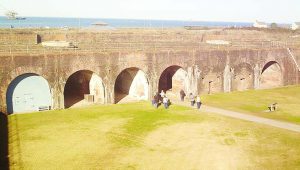
Inside Fort Morgan, looking towards Sally Port today.
Fort Morgan would serve in many capacities from March to July 1837. 3500 Creek Indians from interior Alabama would be sent to the fort to await transportation to Arkansas. Latter in history a little before midnight Jan. 3, 1861, Fort Morgan was seized by Alabama state forces as the American Civil War was just starting. For the next three and half years the Confederates worked to strengthen Mobile’s defense from Florida to Mississippi. The weakest part of the defense was the shipping channel opposite Ft. Morgan. There were over 180 mines placed in the channel with 18 of the heaviest guns of the fort protecting the channel. The Confederates best iron clad, the CSS Tennessee, plus three other gun boats helped block the channel into Mobil Bay. Two of the cannons the fort had for the defense of the bay were 7-inch Brooke Rifles capable of firing a 98-pound projectile over 4 miles.
Not all of the cannons where safe to shoot. The Confederate commander of Fort Morgan on April 30, 1863, was watching one of the new refurbished 32-pounder smoothbore cannon that was freshly rifled to give it greater range and harder hitting power ruptured and it killed him. The whole gun crew was killed or seriously injured. Re-rifling old smoothbore cannons was a common practice but it did weaken the barrels.
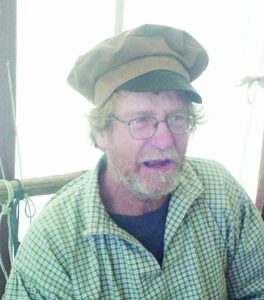
Dick Bennett a past NMLRA director and the owner of Rembrandt Leather.
On Aug. 5, 1864 Admiral David Farragut’s Union Fleet of 18 warships, including four ironclad monitors, entered Mobil Bay in double column. He received a devastating barrage from both forts, but only lost the ironclad USS Tecumseh when it hit a mine. He defeated the small Confederate naval force and forced them to surrender. Ft. Gaines would surrender Aug. 8 and Ft. Morgan would surrender Aug. 23, 1864. The city of Mobile would not surrender until April 12, 1865 three days after the surrender of Lee at Appomattox Courthouse. The fort is still there and if you are in the area drop in and imagine being stationed there during the War of 1812 or the Civil War. When you travel be sure to visit sites like these and learn more about your county’s history.
After leaving Alabama, I did get over to the 47th Annual Alafia River Rendezvous. It was great. It was the largest rendezvous I have been to in years. I got to meet Mark Landon the Chief Range Officer for the event. The ranges looked great and I am looking forward to attending next year because I will shoot. Many old friends were there: Dick Bennett, Mike Beathe, Ava Francesca, and others. I met Dave Spies who is a club member of the Florida Frontiersmen (they put on the event) and he was passing out Muzzle Blasts magazines and NMLRA membership applications at the range.
The Alafia had many people there that knew the history of the area. I didn’t know on April 2, 1513, Juan Ponce de Leon landed in Florida and he named it La Florida. Florida means “Festival of Flowers” by the Spaniards. When he was exploring Florida, he probably was the first one to introduce the harquebus matchlock to mainland America.
There was a lot happing at the Alafia and the biggest thing there seem to be a lot of young people. I don’t know if it was all the good music, the food, the programs, the shooting; whatever it was, they seem to be doing it right. I’m looking forward to next year.



